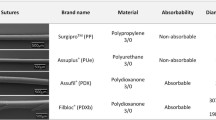Abstract
Incisional hernia is a frequent complication of abdominal surgery developing in 11–20 % of patients undergoing an abdominal operation. Regarding morbidity and loss of manpower, incisional hernias continue to be a fundamental problem for surgeons. In this experimental study, three commonly used mesh materials (Goretex PTFE; Tutoplast Fascia lata; Tutopatch Pericardium bovine) were compared according to effectiveness, strength, adhesion formation, histological changes, and early complications. Three groups, each consisting of 14 rats, have been formed as group A: polytetrafluoroethylene (PTFE), group B: pericardium bovine and group C: fascia lata. Evaluations were achieved at the end of the first and second postoperative week, respectively. Adhesion formation, wound maturation, bursting pressure, and tensile strength were evaluated. No statistically significant difference regarding adhesion formation was observed between groups although adhesion formation was less significant in PTFE and pericardium bovine groups than in the fascia lata group. Bursting pressure and tensile strength values were significantly higher in PTFE group than in the fascia lata group (P <0.05). No statistically significant difference was observed between groups regarding wound maturation. In this experimental model, PTFE and pericardium bovine were found to be superior to fascia lata in abdominal wall repair.

Similar content being viewed by others
References
Bauer JJ, Salky BA, Gelernt IM, Kreel I (1987) Repair of large abdominal wall defects with expanded polytetrafluoroethylene (PTFE). Ann Surg 206: 765–769
Luijendik RW, Hop WCJ, van den Tol MP, de Lange DCD, Braaksma MMJ, Ijzermans JNM, Boelhouver RU, de Vries BC, Salu MKM, Wereldsma JCJ, Bruijninckx CMA, Jeekel J (2000) A comparison of suture repair with mesh repair for incisional hernia. N Engl J Med 343: 392–439
Jenkins SD, Klamer TW, Parteka JJ, Condon RE (1983) A comparison of prosthetic materials used to repair abdominal wall defects. Surgery 94: 392–398
Arnaud JP, Eloy R, Adloff M, Grenier JF (1977) Critical evaluation of prosthetic materials in repair of abdominal wall hernias. New criteria of tolerance and resistance. Am J Surg 133: 338–345
Cengiz Y, Blomquist P, Israelsson L (2001) Small tissue bites and wound strength: An experimental study. Arch Surg 136: 272–275
Meeks GR, Nelson KC, Byars RW (1995) Wound strength in abdominal incisions: A comparison of two continuous mass closure techniques in rats. Am J Obstet Gynecol 173: 1676–1683
Seid MH, McDaniel-Owens LM, Poole GV Jr, Meeks GR (1995) A randomized trial of abdominal incision suture technique and wound strength in rats. Arch Surg 130: 394–397
Hooker GD, Taylor BM, Driman DK (1999) Prevention of adhesion formation with use of sodium hyaluronate-based bioresorbable membrane in a rat model of ventral hernia repair with polypropylene mesh-A randomized, controlled study. Surgery 125: 211–216
Bucknall TE, Cox PJ, Ellis H (1982) Burst abdomen and incisional hernia: A prospective study of 1129 major laparotomies. Br Med J 284: 931–933
Lamont PM, Ellis H (1988) Incisional hernia in re-opened abdominal incisions: An overlooked risk factor. Br J Surg 75: 374–376
Poole GV (1985) Mechanical factors in abdominal wound closure: The prevention of fascial dehiscence. Surgery 97: 631–640
Sayar R, Bilgel H, Korun N, Tasdelen I, Kızıl A (1990) İnsizyonel herni oluşumunda ve onarımında etkili faktörler. Ulusal Cerrahi Dergisi 6: 56–58
Mathes SJ, Steinwald PM, Foster RD, Hoffman WY, Anthony JP (2000) Complex abdominal wall reconstruction: A comparison of flap and mesh closure. Ann Surg 232: 586–596
Vrijland WW, Jeekel J, Steyerberg EW, den Hoed PT, Bonjer HJ (2000) Intraperitoneal polypropylene mesh repair of incisional hernia is not associated with enterocutaneous fistula. Br J Surg 87: 348–352
Kelami A (1975) Duraplasty of the urinary bladder results after two to six years. Eur Urol 1: 178–181
Larson GM, Harrower HW (1978) Plastic mesh repair of incisional hernias. Am J Surg 135: 559–563
Popp LW (1990) Endoscopic patch repair of inguinal hernia in a female patient. Surg Endosc 4: 10–12
Bergeroğlu U, Alagöl H (1993) Reconstruction of a chest-wall defect with dehyrated human dura mater graft. Thorac Cardiovasc Surg 41: 442–443
Caga T, Avatgil R, Sezgin Ç, Sahin A, Ihtiyar E (1995) Reconstruction of a bilateral inguinal hernia with dehyrated human dura mater graft. J Health Sci 7: 127–131
Delmore JE, Turner DA, Gershenson DM, Horbelt DV (1987) Perineal hernia repair using human dura. Obstet Gynecol 70: 507–508
Erverdi N, Fenemen Y, Bengisun U, Ozbas S, Torun N (1996) Geniş karın duvarı defektlerinin tamirinde dura mater greftlerinin kullanımı. Bursa Devlet Hastanesi Bülteni 12: 73–74
Quilici PJ, Vieta JO, Privitera L (1985) The use of dura mater allograft in the surgical repair of large defects of the abdominal wall. Surg Gynecol Obstet 161: 47–48
Akin ML, Erenoğlu C, Uluutku H, Aslan A, Demirel D, Batkin A (2001) Abdominal duvar defektlerinin primer ve sentetik greft ile onarımı. Çağdaş Cerrahi Dergisi 15: 3–10
Elliot MP, Juler GL (1979) Comparison of marlex mesh and microporous teflon sheets when used for hernia repair in the experimental animal. Am J Surg 137: 342–344
Hengirmen S, Cete M, Soran A, Aksoy F, Sencer H, Olcay E (1998) Comparison of meshes for the repair of experimental abdominal wall defects. J Invest Surg 11: 315–325
Author information
Authors and Affiliations
Corresponding author
Rights and permissions
About this article
Cite this article
Kapan, S., Kapan, M., Goksoy, E. et al. Comparison of PTFE, pericardium bovine and fascia lata for repair of incisional hernia in rat model, experimental study. Hernia 7, 39–43 (2003). https://doi.org/10.1007/s10029-002-0096-7
Received:
Accepted:
Published:
Issue Date:
DOI: https://doi.org/10.1007/s10029-002-0096-7




